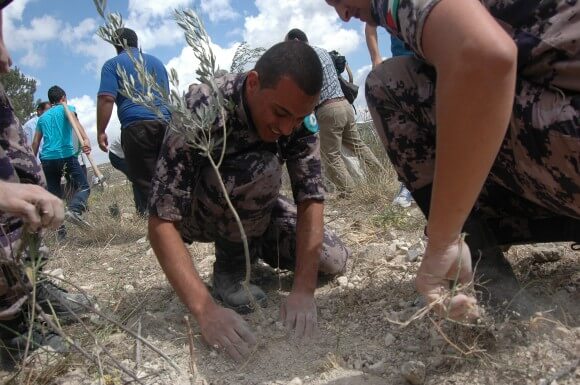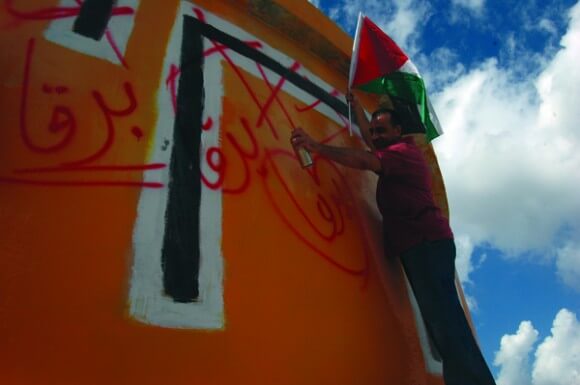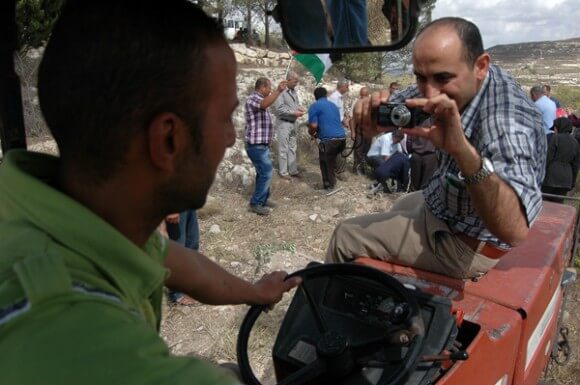
After 35 years, deliverance has finally come to the village of Burqa. Decades ago the West Bank hamlet on a hilltop near Nablus lost part of its agricultural grounds when it was confiscated for an Israeli army post, and then later converted into the settlement of Homesh in the 1980s. But in a first in the West Bank, Israel’s high court has restored the former settlement back to the original Palestinian owners.
“Homesh was evacuated and demolished, but still the military order to seize the land remained valid, and the Palestinians could not enter,” said Burqa’s counsel Anu Deuelle Luski, an attorney with the Israeli legal rights firm Yesh Din.
“In 2010 Yesh Din started legal procedures. We went to the court, submitted a petition and demanded to cancel the seizure order that dated back to 1978,” continued Luski. “After a two and a half year trail the state finally cancelled the closed military zone designation,” she said.

Yesterday, on the heels of the ruling, Burqa’s villagers reclaimed the hill. Arabic music blared from a sound system and the farmers took turns riding on the hood of a tracker while tiling the rocky soil. Every moment of arduous work was celebrated. As the earth was upturned, a cloud of dirt flooded the air with the sharp smell of anise, which had spread across the one time orchard after decades of neglect. There were jokes that the field smelled like a late night of drinking arak, an alcohol made from the yellow-flowering plant.
“We want to build a hospital, a university, a hotel and an airport” said Amid Nimer Faiz Salah from Burqa who was dizzy with excitement. Salah owns around 45 of the 2,500 dunums that were delivered back to the Palestinian community. Before the military confiscation, “we used to farm and plan wheat, and apples and almond trees,” said Salah. But when Homesh was constructed the settlers “blocked the roads, we couldn’t reach the land and they used to shoot at us.”

Homesh used to be a secular Israeli bedroom community of central Israel’s Kfar Saba. But then the first Intifada struck and the instability sent the moderates back inside the Jewish state’s 1967 borders. Yet the settlement remained and religious-nationalists replaced the previous, more liberal population, coinciding with the country’s overall political turn to the right. However, the state intervened in 2005 and Homesh was marked for eviction as part of the negotiated disengagement plan.
But it took several evacuations for Homesh to finally be cleared of it’s settlers, and the fallout was dramatic. Homesh residents established the group “Homesh First.” They organized protests with thousands, the Israeli Defense Forces (IDF) arrested a handful of rightists, and when the atmosphere finally calmed the settlers returned to illegally construct a Yeshiva, or religious school. Then in 2007 Homesh got a big break. Some of their residents had been camping in a nearby forest when Knesset members from the nationalist bloc and Benjamin Netanyahu’s Likud party formed a working group. The political machine they established is still lobbying on the settlers behalf. Yesterday Israel’s housing minister Uri Ariel told Israel National News the high court ruling, “sends the wrong message to the Arabs, the results of which are seen on the ground.”
The remnants of the Homesh are still visible today. Invasive bushes of pink flowers and unattended palm trees line spherical paved roads that are the hallmark of Israeli outpost landscaping. At the top of the hill there is a water tower painted in Hebrew with the words “Homesh First,” a reminder that the hardline group hopes to rebuild their community and yeshiva. Dismayed over the lingering symbol of the territorial confiscation, when the Palestinians first arrived at the land yesterday, before farming, before speeches of their victory, before an appearance from the mayor of Nablus, the villagers spray-painted black “X”’s over the Hebrew letters, and then blotted out the settler group’s name altogether with buckets of white paint. Later that evening, members of Homesh First returned to the site and again branded the water town with their organization’s name.


These illegal settlers are Jews? Exodus 20:17
It’s important to know that the Jewish people will return to Homesh. The tragedy of the disengagement will become undone.
The smile of the fireman in the top photo could not be more genuine or pleasing. It does my heart good to see these people taking joy in these far too rare incremental victories.
It,s just too bad we did not get to see the illegal settler scurvy being dragged out of there.That would have made the picture complete.
RE: “[T]he state intervened in 2005 and Homesh was marked for eviction as part of the negotiated disengagement plan. But it took several evacuations for Homesh to finally be cleared of it’s settlers, and the fallout was dramatic.” ~ Deger
AS AN EXAMPLE OF SETTLER ZEALOTRY, SEE – “Video: Arrest of settler who bolted himself to floor”, by Itamar Fleishman, YnetNews.com, 9/27/13
Bags filled with urine, feces thrown at police officers during arrest of Yitzhar resident Boaz Albert, who violated administrative order banning him from settlement. It took police hours to unchain him from floor. [Take a look at this PHOTO! – J.L.D.]
LINK TO ARTICLE AND VIDEO – http://www.ynetnews.com/articles/0,7340,L-4433829,00.html